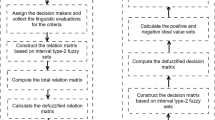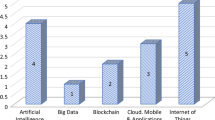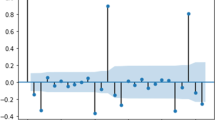Abstract
Nowadays innovation is a key issue in all business sectors, maintaining a positive correlation with the countries’ economic development. The banking sector stands out among the different economic sectors, as globalization has pushed banks into tough competition. Hence, banks within this competitive framework must innovate by developing new products to be competitive and survive. The innovation in banking products is usually sorted as incremental or disruptive. Therefore, this paper aims to evaluate the innovation policies for the European Banking Sector by analyzing incremental and disruptive innovation policies. The novelty of the paper is to propose a set of dimensions and criteria for the innovation policies of European banking industry and to construct a hybrid decision-making model based on interval type-2 fuzzy sets. Accordingly, a comparative analysis of the top five GDP European countries has been carried out using a multiple criteria decision model (MCDM). The MCDM defines different criteria for incremental and disruptive innovations according to the specialized literature. Interval type-2 fuzzy DEMATEL (IT2 FDEMATEL) is used for weighting factors, and interval type-2 fuzzy VIKOR (IT2 FVIKOR) and interval type-2 fuzzy TOPSIS (IT2 FTOPSIS) are considered for ranking alternatives in the integrated modeling. Eventually, the findings highlight the most important criteria in this analysis and the results demonstrate that the comparative analysis of IT2 FVIKOR and IT2 FTOPSIS provides comprehensive and coherent results to select the best country in the innovation policies. In addition, the need to redesign the European banking system with necessary regulations to contribute to the development of the innovations is pointed out.

Similar content being viewed by others
References
Naranjo-Valencia, J.C., Jiménez-Jiméne, D., Sanz-Valle, R.: Studying the links between organizational culture, innovation, and performance in Spanish companies. Revista Latinoamericana de Psicología 48(1), 30–41 (2016)
Osiyevskyy, O., Dewald, J.: Explorative versus exploitative business model change: the cognitive antecedents of firm-level responses to disruptive innovation. Strateg Entrep. J. 9(1), 58–78 (2015)
Fiordelisi, F., Mare, D.S.: Competition and financial stability in European cooperative banks. J. Int. Money Finan. 45, 1–16 (2014)
Kostopoulos, K., Papalexandris, A., Papachroni, M., Ioannou, G.: Absorptive capacity, innovation, and financial performance. J. Bus. Res. 64(12), 1335–1343 (2011)
Faems, D., De Visser, M., Andries, P., Van Looy, B.: Technology alliance portfolios and financial performance: value-enhancing and cost-increasing effects of open innovation. J. Prod. Innov. Manag. 27(6), 785–796 (2010)
Zahra, S.A., Das, S.R.: Innovation strategy and financial performance in manufacturing companies: An empirical study. Prod. oper. Manag. 2(1), 15–37 (1993)
Aspara, J., Hietanen, J., Tikkanen, H.: Business model innovation vs replication: financial performance implications of strategic emphases. J. Strateg. Market. 18(1), 39–56 (2010)
Merton, R.C.: Financial innovation and economic performance. J. Appl. Corp. Finan. 4(4), 12–22 (1992)
Liao, T.S., Rice, J.: Innovation investments, market engagement and financial performance: A study among Australian manufacturing SMEs. Res. Policy 39(1), 117–125 (2010)
Ramanathan, R., Ramanathan, U., Bentley, Y.: The debate on flexibility of environmental regulations, innovation capabilities and financial performance—a novel use of DEA. Omega 75, 131–138 (2018)
Ho, K.L.P., Nguyen, C.N., Adhikari, R., Miles, M.P., Bonney, L.: Exploring market orientation, innovation, and financial performance in agricultural value chains in emerging economies. J. Innov. Knowl. 3(3), 154–163 (2018)
Salunke, S., Weerawardena, J., McColl-Kennedy. J.R.: The central role of knowledge integration capability in service innovation-based competitive strategy. Ind. Market. Manag. 76, 144–156 (2019)
Wu, L., Chiu, M.L.: Organizational applications of IT innovation and firm’s competitive performance: A resource-based view and the innovation diffusion approach. J. Eng. Tech. Manage. 35, 25–44 (2015)
Hinterhuber, A., Liozu, S.M.: Is innovation in pricing your next source of competitive advantage? 1. Innovation in Pricing, pp. 11–27. Routledge, Abingdon (2017)
Herrera, M.E.B.: Creating competitive advantage by institutionalizing corporate social innovation. J. Bus. Res. 68(7), 1468–1474 (2015)
Anning-Dorson, T.: Innovation and competitive advantage creation: the role of organisational leadership in service firms from emerging markets. Int. Market. Rev. 34(4), 580–600 (2018)
Chen, Y., Wang, Y., Nevo, S., Benitez-Amado, J., Kou, G.: IT capabilities and product innovation performance: the roles of corporate entrepreneurship and competitive intensity. Inf. Manag. 52(6), 643–657 (2015)
Rubera, G., Kirca, A.H.: You gotta serve somebody: the effects of firm innovation on customer satisfaction and firm value. J. Acad. Mark. Sci. 45(5), 741–761 (2017)
Lun, Y.V., Shang, K.C., Lai, K.H., Cheng, T.C.E.: Examining the influence of organizational capability in innovative business operations and the mediation of profitability on customer satisfaction: an application in intermodal transport operators in Taiwan. Int. J. Prod. Econ. 171, 179–188 (2016)
Bellingkrodt, S., Wallenburg, C.M.: The role of customer relations for innovativeness and customer satisfaction: a comparison of service industries. Int. J. Logist. Manag. 26(2), 254–274 (2015)
Oyner, O., Korelina, A.: The influence of customer engagement in value co-creation on customer satisfaction: searching for new forms of co-creation in the Russian hotel industry. Worldw. Hosp. Tour. Themes 8(3), 327–345 (2016)
Subramanian, N., Gunasekaran, A., Gao, Y.: Innovative service satisfaction and customer promotion behaviour in the Chinese budget hotel: an empirical study. Int. J. Prod. Econ. 171, 201–210 (2016)
Gassmann, O., Schuhmacher, A., von Zedtwitz, M., Reepmeyer, G.: Future directions and trends. Leading Pharmaceutical Innovation, pp. 155–163. Springer, Cham (2018)
Zhang, H., Liang, X., Wang, S.: Customer value anticipation, product innovativeness, and customer lifetime value: the moderating role of advertising strategy. J. Bus. Res. 69(9), 3725–3730 (2016)
Xu L, Tang S: Technology innovation-oriented complex product systems R&D investment and financing risk management: an integrated review. In: Proceedings of the Tenth International Conference on Management Science and Engineering Management, pp 1653–1663, Springer, Singapore, (2017)
Bowers, J., Khorakian, A.: Integrating risk management in the innovation project. Eur. J. Innov. Manag. 17(1), 25–40 (2014)
Nikolova, L.V., Kuporov, J.J., Rodionov, D.G.: Risk management of innovation projects in the context of globalization. Int. J. Econ. Financ. Issues 5(3S), 73–79 (2015)
Gurd, B., Helliar, C.: Looking for leaders: ‘Balancing’ innovation, risk and management control systems. Br. Account. Rev. 49(1), 91–102 (2017)
Kwak, D.W., Seo, Y.J., Mason, R.: Investigating the relationship between supply chain innovation, risk management capabilities and competitive advantage in global supply chains. Int. J. Oper. Prod. Manag. 38(1), 2–21 (2018)
Ali, A., Warren, D., Mathiassen, L.: Cloud-based business services innovation: a risk management model. Int. J. Inf. Manag. 37(6), 639–649 (2017)
Penning-Rowsell, E.C., De Vries, W.S., Parker, D.J., Zanuttigh, B., Simmonds, D., Trifonova, E., Hissel, F., Monbaliu, J., Lendzion, J., Ohle, N., Diaz, P.: Innovation in coastal risk management: an exploratory analysis of risk governance issues at eight THESEUS study sites. Coast. Eng. 87, 210–217 (2014)
Sohag, K., Begum, R.A., Abdullah, S.M.S., Jaafar, M.: Dynamics of energy use, technological innovation, economic growth and trade openness in Malaysia. Energy 90, 1497–1507 (2015)
Malecki, E.J.: Technological innovation and paths to regional economic growth. Growth Policy in the Age of High Technology, pp. 97–126. Routledge, Abingdon (2018)
Pradhan, R.P., Arvin, M.B., Hall, J.H., Nair, M.: Innovation, financial development and economic growth in Eurozone countries. Appl. Econ. Lett. 23(16), 1141–1144 (2016)
Pece, A.M., Simona, O.E.O., Salisteanu, F.: Innovation and economic growth: an empirical analysis for CEE countries. Procedia Econ. Financ. 26, 461–466 (2015)
Capello, R., Lenzi, C.: Spatial heterogeneity in knowledge, innovation, and economic growth nexus: conceptual reflections and empirical evidence. J. Reg. Sci. 54(2), 186–214 (2014)
Galindo, M.Á., Méndez, M.T.: Entrepreneurship, economic growth, and innovation: are feedback effects at work? J. Bus. Res. 67(5), 825–829 (2014)
Rafindadi, A.A.: Does the need for economic growth influence energy consumption and CO2 emissions in Nigeria? Evidence from the innovation accounting test. Renew. Sustain. Energy Rev. 62, 1209–1225 (2016)
Song, C., Oh, W.: Determinants of innovation in energy intensive industry and implications for energy policy. Energy Policy 81, 122–130 (2015)
Kamasak, R.: Determinants of innovation performance: a resource-based study. Procedia Soc. Behav. Sci. 195, 1330–1337 (2015)
Pishdar, M.: Application of interval type-2 Fuzzy DEMATEL for evaluation of environmental good governance components. Int. J. Resist. Econ. 3(4), 27–44 (2015)
Baykasoğlu, A., Gölcük, İ.: Development of an interval type-2 fuzzy sets based hierarchical MADM model by combining DEMATEL and TOPSIS. Expert Syst. Appl. 70, 37–51 (2017)
Hosseini, M.B., Tarokh, M.J.: Interval type-2 fuzzy set extension of DEMATEL method. Computational Intelligence and Information Technology, pp. 157–165. Springer, Berlin (2011)
Lin, Z.C., Hong, G.E., Cheng, P.: F: a study of patent analysis of LED bicycle light by using modified DEMATEL and life span. Adv. Eng. Inform. 34, 136–151 (2017)
Chen, J.K., Chen, I.: S: A network hierarchical feedback system for Taiwanese universities based on the integration of total quality management and innovation. Appl. Soft Comput. 12(8), 2394–2408 (2012)
Zhu, Q., Sarkis, J., Lai, K.H.: Supply chain-based barriers for truck-engine remanufacturing in China. Transp. Res. Part E Logist. Transp. Rev. 68, 103–117 (2014)
Ahmadi, H., Nilashi, M., Ibrahim, O.: Organizational decision to adopt hospital information system: an empirical investigation in the case of Malaysian public hospitals. Int. J. Med. Inf. 84(3), 166–188 (2015)
Asad, M.M., Mohajerani, N.S., Nourseresh, M.: Prioritizing factors affecting customer satisfaction in the internet banking system based on cause and effect relationships. Procedia Econ. Finan. 36(16), 210–219 (2016)
Wu, H.Y.: Constructing a strategy map for banking institutions with key performance indicators of the balanced scorecard. Eval. Progr. Plann. 35(3), 303–320 (2012)
Dinçer, H., Yüksel, S., Martínez, L.: Analysis of balanced scorecard-based SERVQUAL criteria based on hesitant decision-making approaches. Comput. Ind. Eng. 131, 1–12 (2019)
Qin, J., Liu, X., Pedrycz, W.: An extended VIKOR method based on prospect theory for multiple attribute decision making under interval type-2 fuzzy environment. Knowl. Based Syst. 86, 116–130 (2015)
Ghorabaee, M.K., Amiri, M., Sadaghiani, J.S., Zavadskas, E.K.: Multi-criteria project selection using an extended VIKOR method with interval type-2 fuzzy sets. Int. J. Inf. Technol. Decis. Mak. 14(05), 993–1016 (2015)
Liu, K., Liu, Y., Qin, J.: An integrated ANP-VIKOR methodology for sustainable supplier selection with interval type-2 fuzzy sets. Granul. Comput. 3, 1–16 (2018)
Cevik Onar, S., Oztaysi, B., Kahraman, C.: Strategic decision selection using hesitant fuzzy TOPSIS and interval type-2 fuzzy AHP: a case study. Int. J. Comput. Intell. Syst. 7(5), 1002–1021 (2014)
Dymova, L., Sevastjanov, P., Tikhonenko, A.: An interval type-2 fuzzy extension of the TOPSIS method using alpha cuts. Knowl. Based Syst. 83, 116–127 (2015)
Liao, T.W.: Two interval type 2 fuzzy TOPSIS material selection methods. Mater. Des. 88, 1088–1099 (2015)
Sang, X., Liu, X.: An analytical solution to the TOPSIS model with interval type-2 fuzzy sets. Soft. Comput. 20(3), 1213–1230 (2016)
Gupta, H., Barua, M.: K: A framework to overcome barriers to green innovation in SMEs using BWM and Fuzzy TOPSIS. Sci. Total Environ. 633, 122–139 (2018)
Sun, L.Y., Miao, C.L., Yang, L.: Ecological-economic efficiency evaluation of green technology innovation in strategic emerging industries based on entropy weighted TOPSIS method. Ecol. Indic. 73, 554–558 (2017)
Gupta, H., Barua, M.K.: Supplier selection among SMEs on the basis of their green innovation ability using BWM and fuzzy TOPSIS. J. Clean. Prod. 152, 242–258 (2017)
Lu, Z., Gao, Y.: & Zhao, W: A TODIM-based approach for environmental impact assessment of pumped hydro energy storage plant. J. Clean. Prod. 248, 119265 (2020)
Nath, S., Sarkar, B.: Performance evaluation of advanced manufacturing technologies: a De novo approach. Comput. Ind. Eng. 110, 364–378 (2017)
Wu, H.Y., Chen, J.K., Chen, I.S.: Innovation capital indicator assessment of Taiwanese Universities: a hybrid fuzzy model application. Expert Syst. Appl. 37(2), 1635–1642 (2010)
Chen, J.K., Chen, I.: S: Aviatic innovation system construction using a hybrid fuzzy MCDM model. Expert Syst. Appl. 37(12), 8387–8394 (2010)
Yin, S.: & Li, B: Academic research institutes–construction enterprises linkages for the development of urban green building: Selecting management of green building technologies innovation partner. Sustain. Cities Soc. 48, 101555 (2019)
Wu, M., Li, C., Fan, J., Wang, X., Wu, Z.: Assessing the global productive efficiency of Chinese banks using the cross-efficiency interval and VIKOR. Emerg. Mark. Rev. 34, 77–86 (2018)
Liang, D., Zhang, Y., Xu, Z., Jamaldeen, A.: Pythagorean fuzzy VIKOR approaches based on TODIM for evaluating internet banking website quality of Ghanaian banking industry. Appl. Soft. Comput. 78, 583–594 (2019)
Wanke, P., Azad, A.K.: Emrouznejad, A: Efficiency in BRICS banking under data vagueness: a two-stage fuzzy approach. Glob. Financ. J. 35, 58–71 (2018)
Seçme, N.Y., Bayrakdaroğlu, A., Kahraman, C.: Fuzzy performance evaluation in Turkish banking sector using analytic hierarchy process and TOPSIS. Expert Syst. Appl. 36(9), 11699–11709 (2009)
Wanke, P., Azad, M.A.K., Barros, C.P.: Predicting efficiency in Malaysian Islamic banks: a two-stage TOPSIS and neural networks approach. Res. Int. Bus. Financ. 36, 485–498 (2016)
Dinçer, H., Yüksel, S.: An integrated stochastic fuzzy MCDM approach to the balanced scorecard-based service evaluation. Math. Comput. Simul. 166, 93–112 (2019)
Wu, H.Y., Tzeng, G.H., Chen, Y.: H: A fuzzy MCDM approach for evaluating banking performance based on Balanced Scorecard. Expert Syst. Appl. 36(6), 10135–10147 (2009)
Chen, S.M., Barman, D.: Adaptive weighted fuzzy interpolative reasoning based on representative values and similarity measures of interval type-2 fuzzy sets. Inf. Sci. 478, 167–185 (2019)
Lee, L.W., Chen, S.M: A new method for fuzzy multiple attributes group decision-making based on the arithmetic operations of interval type-2 fuzzy sets. In: 2008 International conference on machine learning and cybernetics, vol. 6, pp. 3084-3089. IEEE, New York (2008)
Akyuz, E., Celik, E.: A fuzzy DEMATEL method to evaluate critical operational hazards during gas freeing process in crude oil tankers. J. Loss. Prev. Process. Ind. 38, 243–253 (2015)
Dinçer, H., Yüksel, S., Martínez, L.: Interval type 2-based hybrid fuzzy evaluation of financial services in E7 economies with DEMATEL-ANP and MOORA methods. Appl. Soft. Comput. 79, 186–202 (2019)
Opricović, S.: VIKOR method. Multicriteria Optimization of Civil Engineering Systems, pp. 142–175. University of Belgrade-Faculty of Civil Engineering, Belgrade (1998)
Yoon, K., Hwang, C.L.: TOPSIS (technique for order preference by similarity to ideal solution)—a Multiple Attribute Decision Making, w: Multiple Attribute Decision Making—Methods and Applications, A State-of-the-at Survey. Springer Verlag, Berlin (1981)
Hartmann, D.: The economic diversification and innovation system of Turkey from a global comparative perspective. International Innovation Networks and Knowledge Migration, pp. 53–71. Routledge, Abingdon (2016)
Fan JP, Huang J, Oberholzer-Gee F, Zhao M: Bureaucrats as managers and their roles in corporate diversification. J. Corp. Financ. (2017)
Kim, N.S., Park, B., Lee, K.D.: A knowledge based freight management decision support system incorporating economies of scale: multimodal minimum cost flow optimization approach. Inf. Technol. Manag. 17(1), 81–94 (2016)
Banoun, A., Dufour, L., Andiappan, M.: Evolution of a service ecosystem: longitudinal evidence from multiple shared services centers based on the economies of worth framework. J. Bus. Res. 69(8), 2990–2998 (2016)
Tsai, J.M., Chang, C.C., Hung, S.W.: Technology acquisition models for fast followers in high-technological markets: an empirical analysis of the LED industry. Technol. Anal. Strateg. Manag. 30(2), 198–210 (2018)
Ernst, H., Conley, J., Omland, N.: How to create commercial value from patents: the role of patent management. R&D Manag. 46(S2), 677–690 (2016)
Cassanelli, A.N., Fernandez-Sanchez, G., Guiridlian, M.C.: Principal researcher and project manager: who should drive R&D projects? R&D Manag. 47(2), 277–287 (2017)
Neimark, B.D.: Biofuel imaginaries: the emerging politics surrounding ‘inclusive’ private sector development in Madagascar. J. Rural Stud. 45, 146–156 (2016)
Witell, L., Snyder, H., Gustafsson, A., Fombelle, P., Kristensson, P.: Defining service innovation: a review and synthesis. J. Bus. Res. 69(8), 2863–2872 (2016)
Tang, T.W., Wang, M.C.H., Tang, Y.Y.: Developing service innovation capability in the hotel industry. Serv. Bus. 9(1), 97–113 (2015)
Grilli, L., Murtinu, S.: Government, venture capital and the growth of European high-tech entrepreneurial firms. Res. Policy 43(9), 1523–1543 (2014)
Hsia, J.W., Chang, C.C., Tseng, A.H.: Effects of individuals’ locus of control and computer self-efficacy on their e-learning acceptance in high-tech companies. Behav. Inf. Technol. 33(1), 51–64 (2014)
Gomez, J., Lanzolla, G., Maicas, J.P.: The role of industry dynamics in the persistence of first mover advantages. Long Range Plan. 49(2), 265–281 (2016)
Wilkie, D.C., Johnson, L.W.: Is there a negative relationship between the order-of-brand entry and market share? Mark. Lett. 27(2), 211–222 (2016)
Romano, G., Guerrini, A., Marques, R.C.: European Water Utility Management: promoting efficiency, innovation and knowledge in the water industry. Water Resour. Manag. 31(8), 2349–2353 (2017)
Carneiro, J., Bamiatzi, V., Cavusgil, S.T.: Organizational slack as an enabler of internationalization: the case of large Brazilian firms. Int. Bus. Rev. 27, 1057–1064 (2018)
Subramanian, A.M., Soh, P.H.: Linking alliance portfolios to recombinant innovation: the combined effects of diversity and alliance experience. Long Range Plan. 50(5), 636–652 (2017)
Acknowledgements
The work was partly supported by the Spanish National research project PGC2018-099402-B-I00 and ERDF funds.
Author information
Authors and Affiliations
Corresponding author
Ethics declarations
Conflict of Interest
The authors of this paper declare that they have no conflict of interest and certify that they have NO affiliations with or involvement in any organization or entity with any financial interest, or non-financial interest in the subject matter or materials discussed in this manuscript.
Rights and permissions
About this article
Cite this article
Dinçer, H., Yüksel, S. & Martínez, L. A Comparative Analysis of Incremental and Disruptive Innovation Policies in the European Banking Sector with Hybrid Interval Type-2 Fuzzy Decision-Making Models. Int. J. Fuzzy Syst. 22, 1158–1176 (2020). https://doi.org/10.1007/s40815-020-00851-8
Received:
Revised:
Accepted:
Published:
Issue Date:
DOI: https://doi.org/10.1007/s40815-020-00851-8




